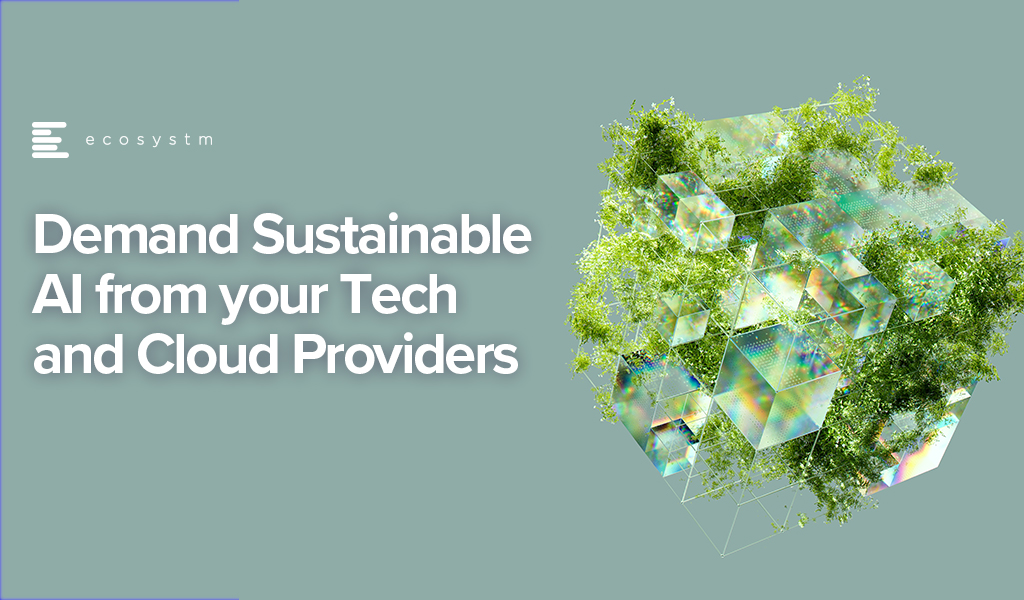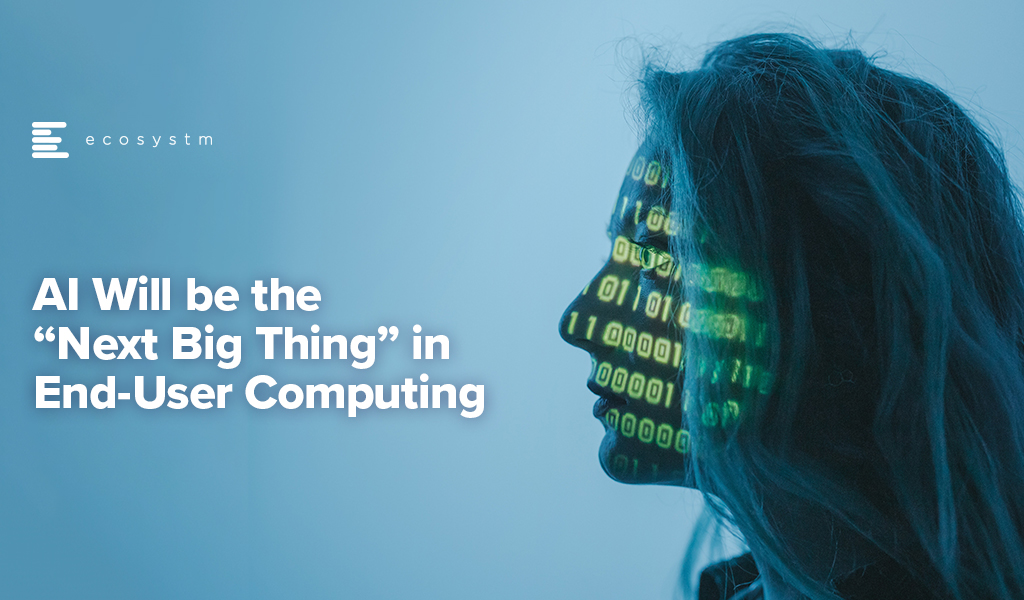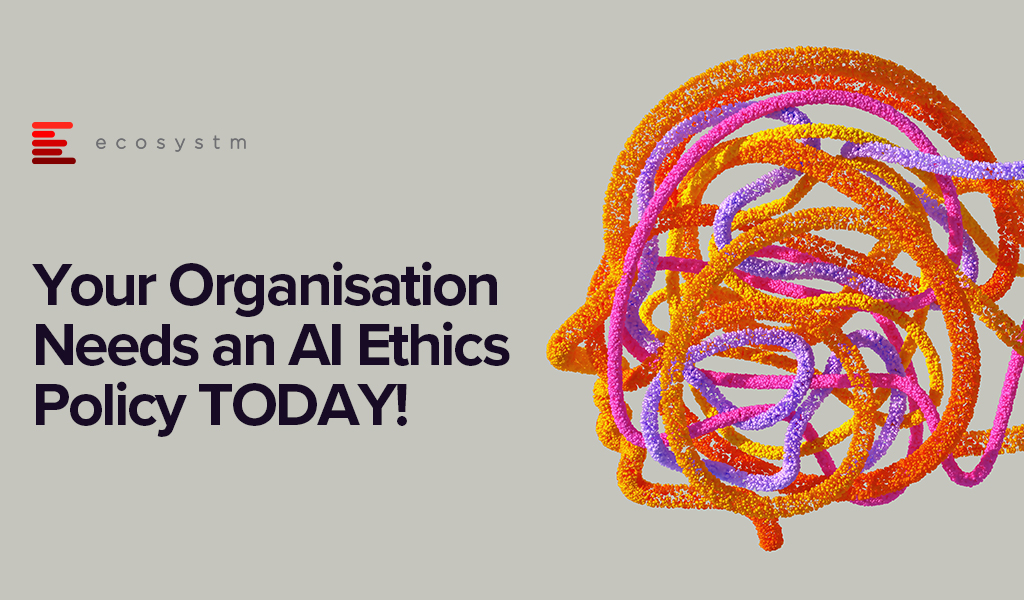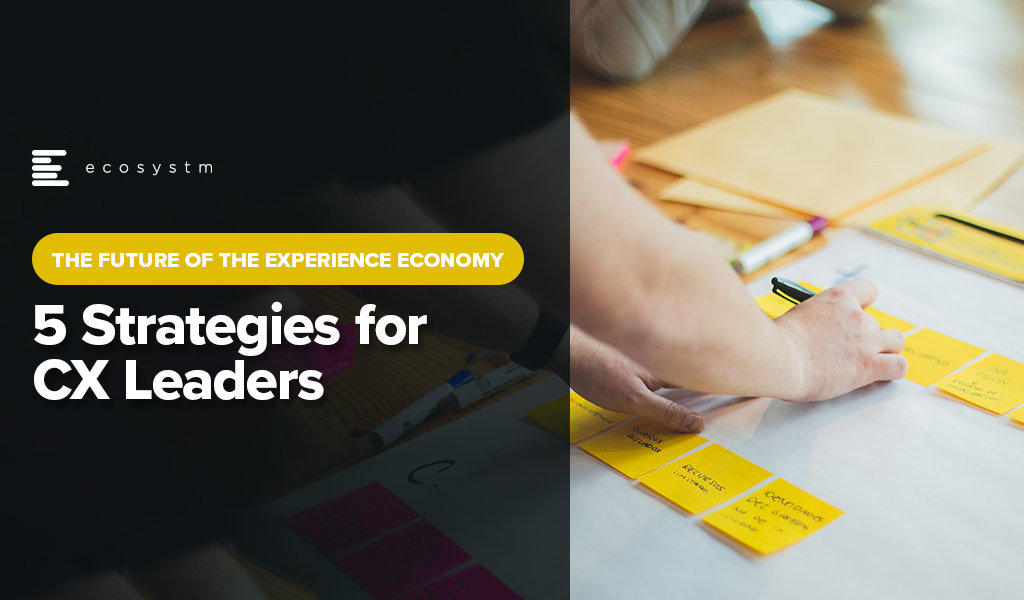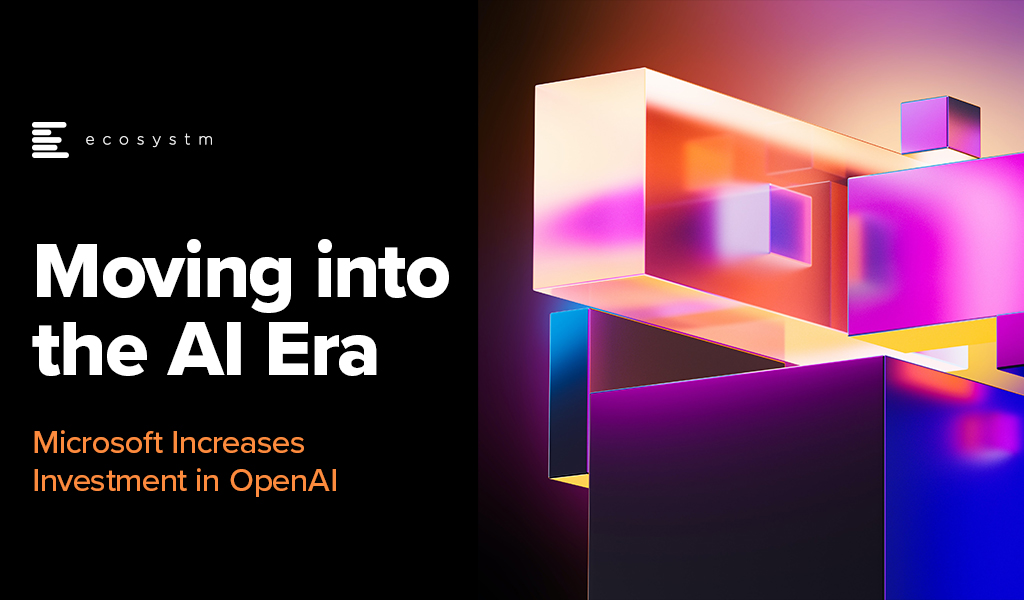As an industry, the tech sector tends to jump on keywords and terms – and sometimes reshapes their meaning and intention. “Sustainable” is one of those terms. Technology vendors are selling (allegedly!) “sustainable software/hardware/services/solutions” – in fact, the focus on “green” or “zero carbon” or “recycled” or “circular economy” is increasing exponentially at the moment. And that is good news – as I mentioned in my previous post, we need to significantly reduce greenhouse gas emissions if we want a future for our kids. But there is a significant disconnect between the way tech vendors use the word “sustainable” and the way it is used in boardrooms and senior management teams of their clients.
Defining Sustainability
For organisations, Sustainability is a broad business goal – in fact for many, it is the over-arching goal. A sustainable organisation operates in a way that balances economic, social, and environmental (ESG) considerations. Rather than focusing solely on profits, a sustainable organisation aims to meet the needs of the present without compromising the ability of future generations to meet their own needs.
This is what building a “Sustainable Organisation” typically involves:
Economic Sustainability. The organisation must be financially stable and operate in a manner that ensures long-term economic viability. It doesn’t just focus on short-term profits but invests in long-term growth and resilience.
Social Sustainability. This involves the organisation’s responsibility to its employees, stakeholders, and the wider community. A sustainable organisation will promote fair labour practices, invest in employee well-being, foster diversity and inclusion, and engage in ethical decision-making. It often involves community engagement and initiatives that support societal growth and well-being.
Environmental Sustainability. This facet includes the responsible use of natural resources and minimising negative impacts on the environment. A sustainable organisation seeks to reduce its carbon footprint, minimise waste, enhance energy efficiency, and often supports or initiates activities that promote environmental conservation.
Governance and Ethical Considerations. Sustainable organisations tend to have transparent and responsible governance. They follow ethical business practices, comply with laws and regulations, and foster a culture of integrity and accountability.
Security and Resilience. Sustainable organisations have the ability to thwart bad actors – and in the situation that they are breached, to recover from these breaches quickly and safely. Sustainable organisations can survive cybersecurity incidents and continue to operate when breaches occur, with the least impact.
Long-Term Focus. Sustainability often requires a long-term perspective. By looking beyond immediate gains and considering the long-term impact of decisions, a sustainable organisation can better align its strategies with broader societal goals.
Stakeholder Engagement. Understanding and addressing the needs and concerns of different stakeholders (including employees, customers, suppliers, communities, and shareholders) is key to sustainability. This includes open communication and collaboration with these groups to foster relationships based on trust and mutual benefit.
Adaptation and Innovation. The organisation is not static and recognises the need for continual improvement and adaptation. This might include innovation in products, services, or processes to meet evolving sustainability standards and societal expectations.
Alignment with the United Nations’ Sustainable Development Goals (UNSDGs). Many sustainable organisations align their strategies and operations with the UNSDGs which provide a global framework for addressing sustainability challenges.
Organisations Appreciate Precise Messaging
A sustainable organisation is one that integrates economic, social, and environmental considerations into all aspects of its operations. It goes beyond mere compliance with laws to actively pursue positive impacts on people and the planet, maintaining a balance that ensures long-term success and resilience.
These factors are all top of mind when business leaders, boards and government agencies use the word “sustainable”. Helping organisations meet their emission reduction targets is a good starting point – but it is a long way from all businesses need to become sustainable organisations.
Tech providers need to reconsider their use of the term “sustainable” – unless their solution or service is helping organisations meet all of the features outlined above. Using specific language would be favoured by most customers – telling them how the solution will help them reduce greenhouse gas emissions, meet compliance requirements for CO2 and/or waste reduction, and save money on electricity and/or management costs – these are all likely to get the sale over the line faster than a broad “sustainability” messaging will.

While there has been much speculation about AI being a potential negative force on humanity, what we do know today is that the accelerated use of AI WILL mean an accelerated use of energy. And if that energy source is not renewable, AI will have a meaningful negative impact on CO2 emissions and will accelerate climate change. Even if the energy is renewable, GPUs and CPUs generate significant heat – and if that heat is not captured and used effectively then it too will have a negative impact on warming local environments near data centres.
Balancing Speed and Energy Efficiency
While GPUs use significantly more energy than CPUs, they run many AI algorithms faster than CPUs – so use less energy overall. But the process needs to run – and these are additional processes. Data needs to be discovered, moved, stored, analysed, cleansed. In many cases, algorithms need to be recreated, tweaked and improved. And then that algorithm itself will kick off new digital processes that are often more processor and energy-intensive – as now organisations might have a unique process for every customer or many customer groups, requiring more decisioning and hence more digitally intensive.
The GPUs, servers, storage, cabling, cooling systems, racks, and buildings have to be constructed – often built from raw materials – and these raw materials need to be mined, transported and transformed. With the use of AI exploding at the moment, so is the demand for AI infrastructure – all of which has an impact on the resources of the planet and ultimately on climate change.
Sustainable Sourcing
Some organisations understand this already and are beginning to use sustainable sourcing for their technology services. However, it is not a top priority with Ecosystm research showing only 15% of organisations focus on sustainable procurement.
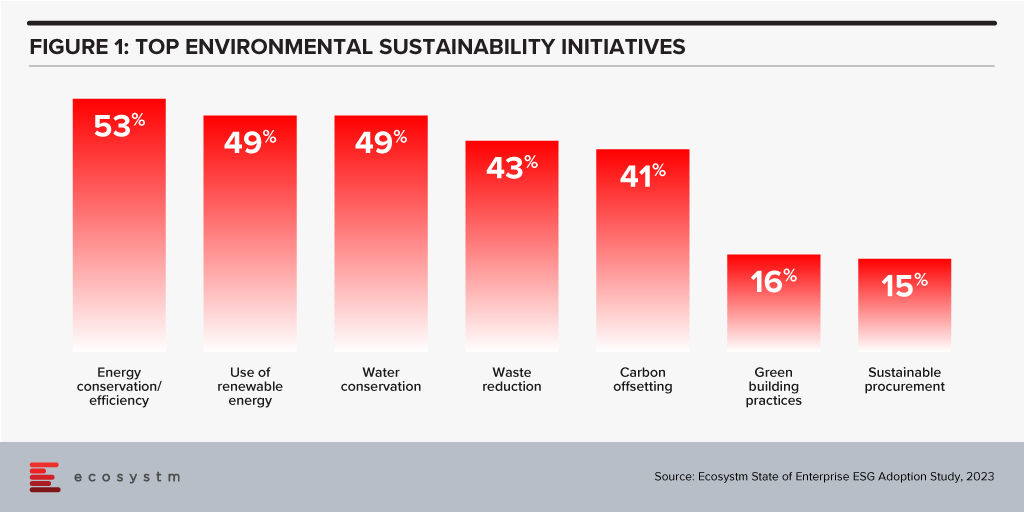
Technology Providers Can Help
Leading technology providers are introducing initiatives that make it easier for organisations to procure sustainable IT solutions. The recently announced HPE GreenLake for Large Language Models will be based in a data centre built and run by Qscale in Canada that is not only sustainably built and sourced, but sits on a grid supplying 99.5% renewable electricity – and waste (warm) air from the data centre and cooling systems is funneled to nearby greenhouses that grow berries. I find the concept remarkable and this is one of the most impressive sustainable data centre stories to date.
The focus on sustainability needs to be universal – across all cloud and AI providers. AI usage IS exploding – and we are just at the tip of the iceberg today. It will continue to grow as it becomes easier to use and deploy, more readily available, and more relevant across all industries and organisations. But we are at a stage of climate warming where we cannot increase our greenhouse gas emissions – and offsetting these emissions just passes the buck.
We need more companies like HPE and Qscale to build this Sustainable Future – and we need to be thinking the same way in our own data centres and putting pressure on our own AI and overall technology value chain to think more sustainably and act in the interests of the planet and future generations. Cloud providers – like AWS – are committed to the NetZero goal (by 2040 in their case) – but this is meaningless if our requirement for computing capacity increases a hundred-fold in that period. Our businesses and our tech partners need to act today. It is time for organisations to demand it from their tech providers to influence change in the industry.

I have spent many years analysing the mobile and end-user computing markets. Going all the way back to 1995 where I was part of a Desktop PC research team, to running the European wireless and mobile comms practice, to my time at 3 Mobile in Australia and many years after, helping clients with their end-user computing strategies. From the birth of mobile data services (GPRS, WAP, and so on to 3G, 4G and 5G), from simple phones to powerful foldable devices, from desktop computers to a complex array of mobile computing devices to meet the many and varied employee needs. I am always looking for the “next big thing” – and there have been some significant milestones – Palm devices, Blackberries, the iPhone, Android, foldables, wearables, smaller, thinner, faster, more powerful laptops.
But over the past few years, innovation in this space has tailed off. Outside of the foldable space (which is already four years old), the major benefits of new devices are faster processors, brighter screens, and better cameras. I review a lot of great computers too (like many of the recent Surface devices) – and while they are continuously improving, not much has got my clients or me “excited” over the past few years (outside of some of the very cool accessibility initiatives).
The Force of AI
But this is all about to change. Devices are going to get smarter based on their data ecosystem, the cloud, and AI-specific local processing power. To be honest, this has been happening for some time – but most of the “magic” has been invisible to us. It happened when cameras took multiple shots and selected the best one; it happened when pixels were sharpened and images got brighter, better, and more attractive; it happened when digital assistants were called upon to answer questions and provide context.
Microsoft, among others, are about to make AI smarts more front and centre of the experience – Windows Copilot will add a smart assistant that can not only advise but execute on advice. It will help employees improve their focus and productivity, summarise documents and long chat threads, select music, distribute content to the right audience, and find connections. Added to Microsoft 365 Copilot it will help knowledge workers spend less time searching and reading – and more time doing and improving.
The greater integration of public and personal data with “intent insights” will also play out on our mobile devices. We are likely to see the emergence of the much-promised “integrated app”– one that can take on many of the tasks that we currently undertake across multiple applications, mobile websites, and sometimes even multiple devices. This will initially be through the use of public LLMs like Bard and ChatGPT, but as more custom, private models emerge they will serve very specific functions.
Focused AI Chips will Drive New Device Wars
In parallel to these developments, we expect the emergence of very specific AI processors that are paired to very specific AI capabilities. As local processing power becomes a necessity for some AI algorithms, the broad CPUs – and even the AI-focused ones (like Google’s Tensor Processor) – will need to be complemented by specific chips that serve specific AI functions. These chips will perform the processing more efficiently – preserving the battery and improving the user experience.
While this will be a longer-term trend, it is likely to significantly change the game for what can be achieved locally on a device – enabling capabilities that are not in the realm of imagination today. They will also spur a new wave of device competition and innovation – with a greater desire to be on the “latest and greatest” devices than we see today!
So, while the levels of device innovation have flattened, AI-driven software and chipset innovation will see current and future devices enable new levels of employee productivity and consumer capability. The focus in 2023 and beyond needs to be less on the hardware announcements and more on the platforms and tools. End-user computing strategies need to be refreshed with a new perspective around intent and intelligence. The persona-based strategies of the past have to be changed in a world where form factors and processing power are less relevant than outcomes and insights.

All growth must end eventually. But it is a brave person who will predict the end of growth for the public cloud hyperscalers. The hyperscaler cloud revenues have been growing at between 25-60% the past few years (off very different bases – and often including and counting different revenue streams). Even the current softening of economic spend we are seeing across many economies is only causing a slight slowdown.
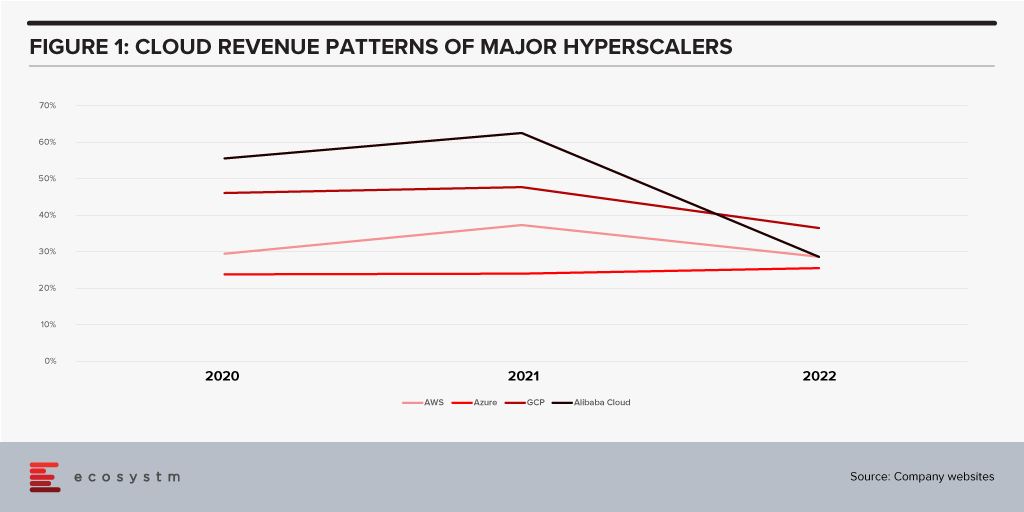
Looking forward, we expect growth in public cloud infrastructure and platform spend to continue to decline in 2024, but to accelerate in 2025 and 2026 as businesses take advantage of new cloud services and capabilities. However, the sheer size of the market means that we will see slower growth going forward – but we forecast 2026 to see the highest revenue growth of any year since public cloud services were founded.
The factors driving this growth include:
- Acceleration of digital intensity. As countries come out of their economic slowdowns and economic activity increases, so too will digital activity. And greater volumes of digital activity will require an increase in the capacity of cloud environments on which the applications and processes are hosted.
- Increased use of AI services. Businesses and AI service providers will need access to GPUs – and eventually, specialised AI chipsets – which will see cloud bills increase significantly. The extra data storage to drive the algorithms – and the increase in CPU required to deliver customised or personalised experiences that these algorithms will direct will also drive increased cloud usage.
- Further movement of applications from on-premises to cloud. Many organisations – particularly those in the Asia Pacific region – still have the majority of their applications and tech systems sitting in data centre environments. Over the next few years, more of these applications will move to hyperscalers.
- Edge applications moving to the cloud. As the public cloud giants improve their edge computing capabilities – in partnership with hardware providers, telcos, and a broader expansion of their own networks – there will be greater opportunity to move edge applications to public cloud environments.
- Increasing number of ISVs hosting on these platforms. The move from on-premise to cloud will drive some growth in hyperscaler revenues and activities – but the ISVs born in the cloud will also drive significant growth. SaaS and PaaS are typically seeing growth above the rates of IaaS – but are also drivers of the growth of cloud infrastructure services.
- Improving cloud marketplaces. Continuing on the topic of ISV partners, as the cloud hyperscalers make it easier and faster to find, buy, and integrate new services from their cloud marketplace, the adoption of cloud infrastructure services will continue to grow.
- New cloud services. No one has a crystal ball, and few people know what is being developed by Microsoft, AWS, Google, and the other cloud providers. New services will exist in the next few years that aren’t even being considered today. Perhaps Quantum Computing will start to see real business adoption? But these new services will help to drive growth – even if “legacy” cloud service adoption slows down or services are retired.
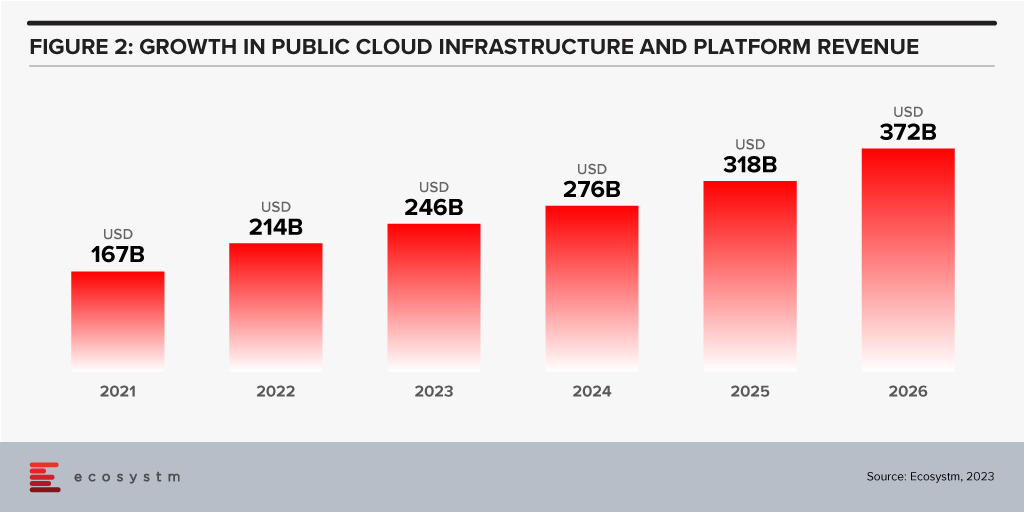
Hybrid Cloud Will Play an Important Role for Many Businesses
Growth in hyperscalers doesn’t mean that the hybrid cloud will disappear. Many organisations will hit a natural “ceiling” for their public cloud services. Regulations, proximity, cost, volumes of data, and “gravity” will see some applications remain in data centres. However, businesses will want to manage, secure, transform, and modernise these applications at the same rate and use the same tools as their public cloud environments. Therefore, hybrid and private cloud will remain important elements of the overall cloud market. Their success will be the ability to integrate with and support public cloud environments.
The future of cloud is big – but like all infrastructure and platforms, they are not a goal in themselves. It is what cloud is and will further enable businesses and customers which is exciting. As the rates of digitisation and digital intensity increase, the opportunities for the cloud infrastructure and platform providers will blossom. Sometimes they will be the driver of the growth, and other times they will just be supporting actors. But either way, in 2026 – 20 years after the birth of AWS – the growth in cloud services will be bigger than ever.

It is not hyperbole to state that AI is on the cusp of having significant implications on society, business, economies, governments, individuals, cultures, politics, the arts, manufacturing, customer experience… I think you get the idea! We cannot understate the impact that AI will have on society. In times gone by, businesses tested ideas, new products, or services with small customer segments before they went live. But with AI we are all part of this experiment on the impacts of AI on society – its benefits, use cases, weaknesses, and threats.
What seemed preposterous just six months ago is not only possible but EASY! Do you want a virtual version of yourself, a friend, your CEO, or your deceased family member? Sure – just feed the data. Will succession planning be more about recording all conversations and interactions with an executive so their avatar can make the decisions when they leave? Why not? How about you turn the thousands of hours of recorded customer conversations with your contact centre team into a virtual contact centre team? Your head of product can present in multiple countries in multiple languages, tailored to the customer segments, industries, geographies, or business needs at the same moment.
AI has the potential to create digital clones of your employees, it can spread fake news as easily as real news, it can be used for deception as easily as for benefit. Is your organisation prepared for the social, personal, cultural, and emotional impacts of AI? Do you know how AI will evolve in your organisation?
When we focus on the future of AI, we often interview AI leaders, business leaders, futurists, and analysts. I haven’t seen enough focus on psychologists, sociologists, historians, academics, counselors, or even regulators! The Internet and social media changed the world more than we ever imagined – at this stage, it looks like these two were just a rehearsal for the real show – Artificial Intelligence.
Lack of Government or Industry Regulation Means You Need to Self-Regulate
These rapid developments – and the notable silence from governments, lawmakers, and regulators – make the requirement for an AI Ethics Policy for your organisation urgent! Even if you have one, it probably needs updating, as the scenarios that AI can operate within are growing and changing literally every day.
- For example, your customer service team might want to create a virtual customer service agent from a real person. What is the policy on this? How will it impact the person?
- Your marketing team might be using ChatGPT or Bard for content creation. Do you have a policy specifically for the creation and use of content using assets your business does not own?
- What data is acceptable to be ingested by a public Large Language Model (LLM). Are are you governing data at creation and publishing to ensure these policies are met?
- With the impending public launch of Microsoft’s Co-Pilot AI service, what data can be ingested by Co-Pilot? How are you governing the distribution of the insights that come out of that capability?
If policies are not put in place, data tagged, staff trained, before using a tool such as Co-Pilot, your business will be likely to break some privacy or employment laws – on the very first day!
What do the LLMs Say About AI Ethics Policies?
So where do you go when looking for an AI Ethics policy? ChatGPT and Bard of course! I asked the two for a modern AI Ethics policy.
You can read what they generated in the graphic below.
I personally prefer the ChatGPT4 version as it is more prescriptive. At the same time, I would argue that MOST of the AI tools that your business has access to today don’t meet all of these principles. And while they are tools and the ethics should dictate the way the tools are used, with AI you cannot always separate the process and outcome from the tool.
For example, a tool that is inherently designed to learn an employee’s character, style, or mannerisms cannot be unbiased if it is based on a biased opinion (and humans have biases!).
LLMs take data, content, and insights created by others, and give it to their customers to reuse. Are you happy with your website being used as a tool to train a startup on the opportunities in the markets and customers you serve?
By making content public, you acknowledge the risk of others using it. But at least they visited your website or app to consume it. Not anymore…
A Policy is Useless if it Sits on a Shelf
Your AI ethics policy needs to be more than a published document. It should be the beginning of a conversation across the entire organisation about the use of AI. Your employees need to be trained in the policy. It needs to be part of the culture of the business – particularly as low and no-code capabilities push these AI tools, practices, and capabilities into the hands of many of your employees.
Nearly every business leader I interview mentions that their organisation is an “intelligent, data-led, business.” What is the role of AI in driving this intelligent business? If being data-driven and analytical is in the DNA of your organisation, soon AI will also be at the heart of your business. You might think you can delay your investments to get it right – but your competitors may be ahead of you.
So, as you jump head-first into the AI pool, start to create, improve and/or socialise your AI Ethics Policy. It should guide your investments, protect your brand, empower your employees, and keep your business resilient and compliant with legacy and new legislation and regulations.

In my last Ecosystm Insight, I spoke about the 5 strategies that leading CX leaders follow to stay ahead of the curve. Data is at the core of these CX strategies. But a customer data breach can have an enormous financial and reputational impact on a brand.
Here are 12 essential steps to effective governance that will help you unlock the power of customer data.
- Understand data protection laws and regulations
- Create a data governance framework
- Establish data privacy and security policies
- Implement data minimisation
- Ensure data accuracy
- Obtain explicit consent
- Mask, anonymise and pseudonymise data
- Implement strong access controls
- Train employees
- Conduct risk assessments and audits
- Develop a data breach response plan
- Monitor and review
Read on to find out more.
Download ‘A 12-Step Plan for Governance of Customer Data’ as a PDF

In good times and in bad, a great customer experience (CX) differentiates your company from your competitors and creates happy customers who turn into brand advocates. While some organisations in Asia Pacific are just starting out on their CX journey, many have made deep investments. But in the fast-paced world of digital, physical and omnichannel experience improvement, if you stand still, you fall behind.
We interviewed CX leaders across the region, and here are the top 5 top actions that they are taking to stay ahead of the curve.
#1 Better Governance of Customer Data
Most businesses accelerate their CX journeys by collecting and analysing data. They copy data from one channel to another, share data across touchpoints, create data silos to better understand data, and attempt to create a single view of the customer. Without effective governance, every time create copies of customer data are created, moved, and shared with partners, it increases the attack surface of the business. And there is nothing worse than telling customers that their data was accessed, stolen or compromised – and that they need to get a new credit card, driver’s license or passport.
To govern customer data effectively, it is essential to collaborate with different stakeholders, such as legal, risk, IT, and CX leaders – data owners, consumers, and managers, analytics leaders, data owners, and data managers – in the strategy discussions.
#2 Creating Human Experiences
To create a human-centric experience, it is important to understand what humans want. However, given that each brand has different values, the expectations of customers may not always be consistent.
Much of the investment in CX by Asian companies over the past five years have been focused on making transactions easy and effective – but ultimately it is the emotional attachment which brings customers back repeatedly. In creating human experiences, brands create a brand voice that is authentic, relatable, empathetic and is consistent across all channels.
Humanising the experience and brand requires:
- Hyperpersonalisation of customer interactions. By efforts such as using names, understanding location requirements, remembering past purchases, and providing tailored recommendations based on their expectations, businesses can make customers feel valued and understood. Understanding the weather, knowing whether the customer’s favourite team won or lost on the weekend, mentioning an important birthday, etc. can all drive real, human experiences – with or without an actual human involved in the process!
- Transparency. Honesty and transparency can go a long way in building trust with customers. Businesses should be open about their processes, pricing, and policies. Organisations should be transparent about mistakes and what they are doing to fix the problem.
#3 Building Co-creation Opportunities
Co-creation is a collaborative approach where organisations involve their customers in the development and improvement of products, services, and experiences. This process can foster innovation, enhance customer satisfaction, and contribute to long-term business success. Co-creation can increase customer satisfaction and loyalty, drive innovation, enhance brand reputation, boost market relevance, and reduce risks and costs.
Strategies for co-creation include:
- Creating open innovation platforms where customers can submit ideas, feedback, and suggestions
- Organising workshops or focus groups that bring together customers, designers, and developers to brainstorm and generate new ideas
- Running contests or crowdsourcing initiatives to engage customers in problem-solving and idea generation
- Establishing feedback loops and engaging customers in the iterative development process
- Partnering with customers or external stakeholders, such as suppliers or distributors, to co-create new products or services
#4 Collecting Data – But Telling Stories
Organisations use storytelling as a powerful CX tool to connect with their customers, convey their brand values, and build trust.
Here are some ways organisations share stories with their customers:
- Brand storytelling. Creating narratives around their brand that showcase their mission, vision, and values
- Customer testimonials and case studies. Sharing real-life experiences of satisfied customers to showcase the value of a product or service
- Content marketing. Creating engaging content in the form of blog posts, articles, videos, podcasts, and more to educate, entertain, and inform their customers
- Social media. Posting photos, videos, or updates that showcase the brand’s personality, to strengthen relationships with the audience
- Packaging and in-store experiences. Creative packaging and well-designed in-store experiences to tell a brand story and create memorable customer interactions
- Corporate social responsibility (CSR) initiatives. Helping customers understand the values the organisation stands for and build trust
#5 Finally – Not Telling Just Positive Stories!
Many companies focus on telling the good stories: “Here’s what happens when you use our products”; “Our customers are super-successful” and; “Don’t just take it from us, listen to what our customers say.”
But memorable stories are created with contrast – like telling the story of what happened when someone didn’t use the product or service. Successful brands don’t want to just leave the audience with a vision of what could be possible, but also what will be likely if they don’t invest. Advertisers have understood this for years, but customers don’t just hear stories through advertisements – they hear it through social media, word of mouth, traditional media, and from sales and account executives.

Microsoft’s intention to invest a further USD 10B in OpenAI – the owner of ChatGPT and Dall-E2 confirms what we said in the Ecosystm Predicts – Cloud will be replaced by AI as the right transformation goal. Microsoft has already invested an estimated USD 3B in the company since 2019. Let’s take a look at what this means to the tech industry.
Implications for OpenAI & Microsoft
OpenAI’s tools – such as ChatGPT and the image engine Dell-E2 – require significant processing power to operate, particularly as they move beyond beta programs and offer services at scale. In a single week in December, the company moved past 1 million users for ChatGPT alone. The company must be burning through cash at a significant rate. This means they need significant funding to keep the lights on, particularly as the capability of the product continues to improve and the amount of data, images and content it trawls continues to expand. ChatGPT is being talked about as one of the most revolutionary tech capabilities of the decade – but it will be all for nothing if the company doesn’t have the resources to continue to operate!
This is huge for Microsoft! Much has already been discussed about the opportunity for Microsoft to compete with Google more effectively for search-related advertising dollars. But every product and service that Microsoft develops can be enriched and improved by ChatGPT:
- A spreadsheet tool that automatically categorises data and extract insight
- A word processing tool that creates content automatically
- A CRM that creates custom offers for every individual customer based on their current circumstances
- A collaboration tool that gets answers to questions before they are even asked and acts on the insights and analytics that it needs to drive the right customer and business outcomes
- A presentation tool that creates slides with compelling storylines based on the needs of specific audiences
- LinkedIn providing the insights users need to achieve their outcomes
- A cloud-based AI engine that can be embedded into any process or application through a simple API call (this already exists!)
How Microsoft chooses to monetise these opportunities is up to the company – but the investment certainly puts Microsoft in the box seat to monetise the AI services through their own products while also taking a cut from other ways that OpenAI monetises their services.
Impact on Microsoft’s competitors
Microsoft’s investment in OpenAI will accelerate the rate of AI development and adoption. As we move into the AI era, everything will change. New business opportunities will emerge, and traditional ones will disappear. Markets will be created and destroyed. Microsoft’s investment is an attempt for the company to end up on the right side of this equation. But the other existing (and yet to be created) AI businesses won’t just give up. The Microsoft investment will create a greater urgency for Google, Apple, and others to accelerate their AI capabilities and investments. And we will see investments in OpenAI’s competitors, such as Stability AI (which raised USD 101M in October 2022).
What will change for enterprises?
Too many businesses have put “the cloud” at the centre of their transformation strategies – as if being in the cloud is an achievement in itself. While cloud made applications and processes are easier to transform (and sometimes cheaper to deploy and run), for many businesses, they have just modernised their legacy end-to-end business processes on a better platform. True transformation happens when businesses realise that their processes only existed because they of lack of human or technology capacity to treat every customer and employee as an individual, to determine their specific needs and to deliver a custom solution for them. Not to mention the huge cost of creating unique processes for every customer! But AI does this.
AI engines have the ability to make businesses completely rethink their entire application stack. They have the ability to deliver unique outcomes for every customer. Businesses need to have AI as their transformation goal – where they put intelligence at the centre of every transformation, they will make different decisions and drive better customer and business outcomes. But once again, delivering this will take significant processing power and access to huge amounts of content and data.
The Burning Question: Who owns the outcome of AI?
In the end, ChatGPT only knows what it knows – and the content that it learns from is likely to have been created by someone (ideally – as we don’t want AI to learn from bad AI!). What we don’t really understand is the unintended consequences of commercialising AI. Will content creators be less willing to share their content? Will we see the emergence of many more walled content gardens? Will blockchain and even NFTs emerge as a way of protecting and proving origin? Will legislation protect content creators or AI engines? If everyone is using AI to create content, will all content start to look more similar (as this will be the stage that the AI is learning from content created by AI)? And perhaps the biggest question of all – where does the human stop and the machine start?
These questions will need answers and they are not going to be answered in advance. Whatever the answers might be, we are definitely at the beginning of the next big shift in human-technology relations. Microsoft wants to accelerate this shift. As a technology analyst, 2023 just got a lot more interesting!

In recent years, businesses have faced significant disruptions. Organisations are challenged on multiple fronts – such as the continuing supply chain disruptions; an ongoing energy crisis that has led to a strong focus on sustainability; economic uncertainty; skills shortage; and increased competition from digitally native businesses. The challenge today is to build intelligent, data-driven, and agile businesses that can respond to the many changes that lie ahead.
Leading organisations are evaluating ways to empower the entire business with data, machine learning, automation, and AI to build agile, innovative, and customer-focused businesses.
Here are 7 steps that will help you deliver business value with data and AI:
- Understand the problems that need solutions. Before an organisation sets out on its data, automation, and AI journey, it is important to evaluate what it wants to achieve. This requires an engagement with the Tech/Data Teams to discuss the challenges it is trying to resolve.
- Map out a data strategy framework. Perhaps the most important part of this strategy are the data governance principles – or a new automated governance to enforce policies and rules automatically and consistently across data on any cloud.
- Industrialise data management & AI technologies. The cumulation of many smart, data-driven initiatives will ultimately see the need for a unified enterprise approach to data management, AI, and automation.
- Recognise the skills gap – and start closing it today. There is a real skills gap when it comes to the ability to identify and solve data-centric issues. Many businesses today turn to technology and business consultants and system integrators to help them solve the skills challenge.
- Re-start the data journey with a pilot. Real-world pilots help generate data and insights to build a business case to scale capabilities.
- Automate the outcomes. Modern applications have made it easier to automate actions based on insights. APIs let systems integrate with each other, share data, and trigger processes; and RPA helps businesses automate across applications and platforms.
- Learn and improve. Intelligent automation tools and adaptive AI/machine learning solutions exist today. What organisations need to do is to apply the learnings for continuous improvements.
Find more insights below.
Download The Future of Business: 7 Steps to Delivering Business Value with Data & AI as a PDF




